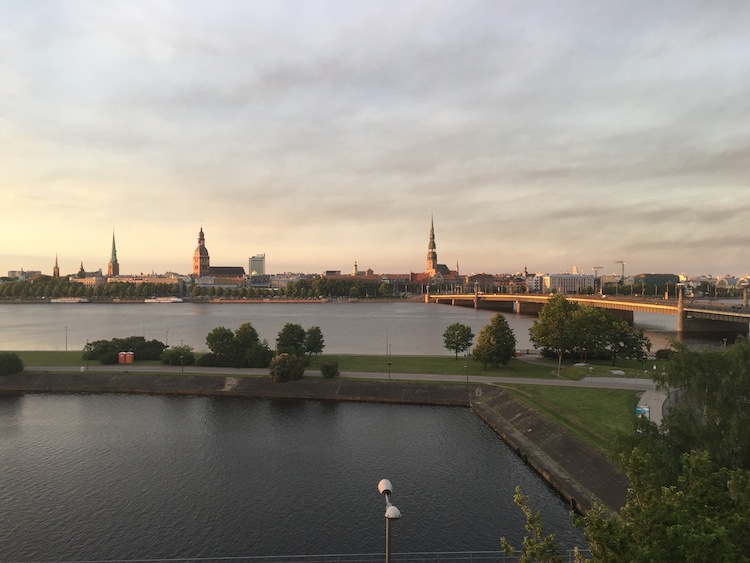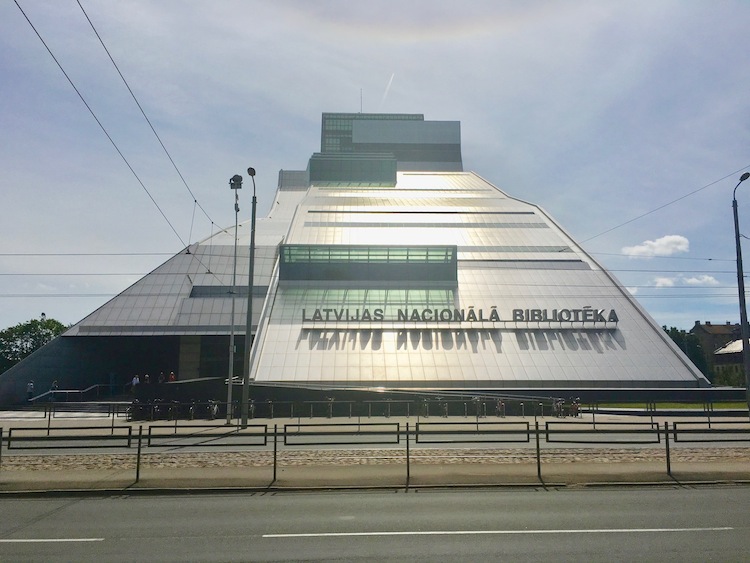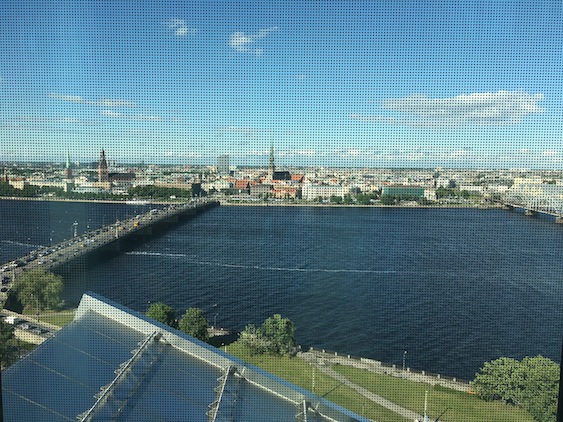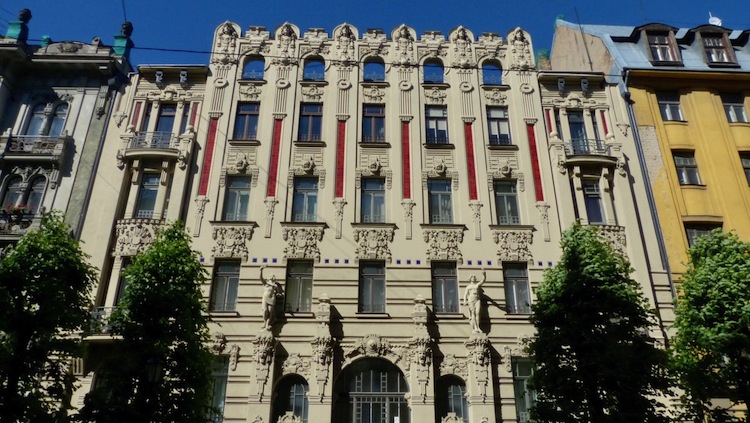The following has reached us from Antony Gordon (retired, British Library):
Here I am at my 24th conference/congress in Riga. Being retired from the British Library Sound Archive and having finished my two three-year terms on the Board last year at the Rome Congress, I felt entitled to take a rather more relaxed approach. The journey to Riga formed part of the overall experience for us so this is inevitably starts out like a travelogue. If you're not interested in train travel you should skip the next paragraph.
Four days before the congress was due to open we started our journey by train into London for St Pancras International station. From there we had our first trip on one of the new Eurostar e320 trains to Brussel Zuid/Bruxelles Midi. Around ten minutes' delay near Brussels made it a bit of a scramble to change platform to catch the ICE train to Köln Hbf, which was helpfully held for five minutes to help the many passengers transferring from Eurostar. At Köln Hbf we took a couple of hours break to revisit our favourite Café Reichard near the station. Through the evening the journey continued northward to Hamburg Hbf for an overnight stop in a nearby hotel. The following morning we set out for København (Copenhagen). On this leg of the journey the train is run onto the ferry at Puttgarden, we all leave the train and move up to the deck for around 45 minutes, then rejoin it as the ferry docks at Rødby in Denmark. From there we crossed bridges linking major islands and arrived in Copenhagen in the early afternoon. Our next booking was for a Swedish X 2000 train from Copenhagen to Stockholm later that afternoon, but an SMS alert from SJ (Swedish Railways) warned us that the train would be started from Malmö on the Swedish side due to earlier problems. It was just as well then that we had plenty of time to find the platform for the local Öresundståg train to Malmö. From Malmö the journey went smoothly, arriving in Stockholm late in the evening where we settled into our 15th floor hotel room with a fine view across the ferry harbour. A day and a half in Stockholm gave us time for a little sightseeing and to meet IAML friends who we knew would not be in Riga. The overnight ferry to Riga sailed at 17.00, and the weather was perfect for spending a couple of hours on deck as we navigated our way through the archipelago. After dinner in the restaurant with a fine view of the few sparse islands remaining, we retired to our cabin for a peaceful night's sleep on a perfectly smooth sailing. After breakfast the next morning we could see the first signs of Latvia, and as we docked in Riga we got our first sight of the Latvijas Nationālā Bibliotēka (Latvian National Library) where the congress was to be held.
From the main conference hotel within about five minutes' walk there was a fine view of the River Daugava and of the old town on the opposite bank.


The opening reception took place that evening in the atrium of the National Library, beginning with some nice short welcome speeches and a short recital on the kokles – a box zither similar to the Finnish kantele. The food and drink provided was excellent and plentiful and there was lots of time to catch up with friends and colleagues – the IAML big family.
Monday morning's opening session was one of the best that I can recall. Ēriks Ešenvalds's multimedia symphony Nordic Light was the subject of the first presentation. He told us of its inspiration, gestation and composition, interspersed with video excerpts of the first performance in Riga, and of diverse people telling stories around the Aurora Borealis that are woven into it. The second presentation by Ints Teterovskis treated us to a history of the Latvian song festival tradition. My day then progressed to a meeting with our Web Editor to discuss projects and technical issues. In the afternoon the Publications Committee meeting brought my busiest day of the week to an end.
That evening we were treated to a wonderful concert in the library's auditorium given by the State Choir LATVIJA, conducted by Māris Sirmais. The programme was of unaccompanied choral music by ten Latvian composers of which only two names were familiar to me: Pēteris Vasks, and Ēriks Ešenvalds, as of earlier the same day. Some of the works had vocal solos, and one of them used a single drum.
Tuesday required a little session hopping. As an existing subscriber I wanted to hear Kathrin Greger tell us more about the Berliner Philharmoniker Digital Concert Hall. Then a quick hop to another session nearby to hear Kimmy Szeto's entertaining and informative presentation on linked data. My one regret is that I'd not noticed 'The trouble with works' presentation had been moved since I last checked the online programme and I had just missed it. Next, a couple of hours of 'freedom' to cross to the old town before dropping into the later part of the Forum of National Branches to promote to national representatives the idea of having IAML mailboxes rather than mail forwarding – not, I suspect, with much success. General Assembly 1 ended the afternoon's sessions.
After GA 1 we took the opportunity to join one of the guided tours of the national library building, starting right at the summit of the building, which apparently was designed to look like a mountain. (Incidentally, when motor traffic was quiet it sounded as if there was a nest of young Peregrines somewhere high on the building.) The windows at the apex of the building are covered in spots to help birds see them and avoid collisions; the (spotted) views were spectacular. On the way down the building we got to see into reading rooms, the music stacks and decorative displays of books, as well as a narrow window that the architect placed to allow a view to one of his favourite churches in the old town.

After the tour we crossed the now decidedly windy river bridge to have dinner with a growing group of IAML friends – nine in all – at a medieval-style restaurant. Sitting with my back to the alto recorder player was a little distracting, but her repertoire was a good subset of the Early Music Consort of London's recordings, with some of Jacob van Eyck's Der Fluyten Lust–Hof.
At the first session I attended on Wednesday Darius Kučinskas spoke about a collection of Lithuanian piano rolls held in the National Library in Vilnius. Later, Samantha Bennett described her 'baptism of fire' into the world of audio conservation when she discovered a collection of analogue tapes that had been proposed for disposal that turned out to contain early performances and examinations at the ANU School of Music.
The Wednesday afternoon tour took us to a part of Riga where there are numerous large buildings in the Jugendstil (Art Nouveau) style. Our excellent guide told us about the architects and the symbolism of the figures and beasts portrayed there. The tour finished back in the centre of the old town at just the right time for an early dinner with another group of friends.

It's Thursday, and already the last day of the congress. General Assembly 2 and Closing Ceremony in the afternoon would be a must but before that a last opportunity to visit the old town. We found ourselves in the midst of a large market next to an open-air stage with children dancing – the start of the Latvian midsummer festival.
In the evening the Farewell Reception was in the Riga Latvian Society House Grand Hall. Unusually and very generously the reception had been included in the conference fee so that everyone was invited to a sit-down serve-yourself meal. Presentations were made to Zane Grosa and Viktorija Moskina (our wonderful principal organizers) before we were entertained by a folksinging group who later moved to an adjacent room to lead folk dancing (for the brave) and floral garland construction.
Riga 2017 was a most enjoyable, well organized and memorable congress. In contrast with the outward journey, our return was an entirely unremarkable couple of flights. I'm already looking forward to Leipzig 2018 and Kraków 2019 – more nice train journeys.


Kommentare
Inspired!